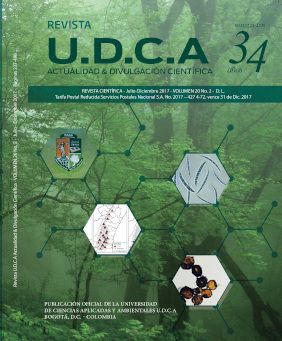Estimulación de germinación y colonización radicular de Diversispora trimulares por flavonoides de exudados radiculares de Nicotiana glauca
Stimulation of germination of spores and root colonization of Diversispora trimulares by flavonoids in Nicotiana glauca root exudates
Contenido principal del artículo
Resumen
Los metabolitos secundarios son señales importantes en la interacción planta-microrganismos; sin embargo, los datos que corroboran el rol de los flavonoides como señales entre plantas y la simbiosis micorrízica arbuscular son limitados y aún recientes. Este estudio tiene por objetivo evaluar el efecto de flavonoides presentes en exudados radiculares de Allium porrum L., Nicotiana gluaca y Brassica oleracea var. Itálica, en la germinación de esporas y establecimiento de colonización radicular de Diversispora trimulares. Se detectaron miricetina y canferol en exudados de A. porrum, con un contenido total de flavonoides de 23,80µg g-1, de raíz seca; quercetina, en N. glauca, con 23,35µg g-1 y crisina, en B. oleracea, con 14,71µg g-1. Quercetina estimuló la germinación y la vitalidad de esporas (24%, 40%), a diferencia de crisina, que presentó un efecto inhibitorio (4%, 20%). A. porrum y N. glauca incrementaron la germinación de esporas (54%, 56%) y porcentaje de colonización de micorriza arbuscular (72%, 75%). Los resultados de la investigación mostraron una evidencia sólida del efecto de los flavonoides como moléculas estimulantes en los procesos de germinación de esporas y colonización de micorriza arbuscular.
Palabras clave:
Descargas
Datos de publicación
Perfil evaluadores/as N/D
Declaraciones de autoría
- Sociedad académica
- Universidad de Ciencias Aplicadas UDCA
- Editorial
- Universidad de Ciencias Aplicadas y Ambientales U.D.C.A
Detalles del artículo
Referencias (VER)
ABDEL-LATEIF, K.; BOGUSZ, D.; HOCHER, V. 2012. The role offlavonoids in the establishment of plant roots endosymbioses with arbuscular mycorrhiza fungi, rhizobia and Frankia bacteria. Plant Signaling & Behavior. (Estados Unidos). 7(6):636-641.
BANSAL, M.; JAGPAL, R.; MUKERJI, K. 1991. Viability of VAM fungal spores. Recent Advances in Applied Sciences. (Estados Unidos). 6:65-68.
BECARD, G.; DOUDS, D.; PFEFFER, P. 1992. Extensive in vitro hyphal growth of vesicular-arbuscular mycorrizhal fungi in the presence of CO2 and flavonols. Applied and Environmental Microbiology. (Estados Unidos). 58(3):821-825.
BÜCKING, H.; ABUBAKER, J.; GOVINDARAJULU, M.; TALA, M.; PFEFFER, P.E.; NAGAHASHI, G.; SHACHAR-HILL, Y. 2008. Root exudates stimulate the uptake and metabolism of organic carbon in germinating spores of Glomus intraradices. New Phytologist. (Reino Unido). 180(3):684-695.
BUEE, M.; ROSSIGNOL, M.; JAUNEAU, A.; RANJEVA, R.; BECARD, G. 2000. The Pre-Symbiotic Growth of arbuscular mycorrhizal fungi is induced by a branching factor partially purified from plant root exudates. The American Phytopathological Society. (Estados Unidos). 13(6):693-698.
CHABOT, S.; BEL-RHLID, R.; CHENEVERT, R.; PICHÉ, Y. 1992. Hyphal growth promotion in vitro of the VA mycorrhizal fungus, Gigaspora margarita Becker & Hall, by the activity of structurally specific flavonoid compounds under CO2-enriched conditions. New Phytologist. 122(3):461-467.
CESCO, S.; MIMMO, T.; TONON, G.; TOMASI, N.; PINTON, R.; TERZANO, R.; NANNIPIERI, P. 2012. Plant-borne flavonoids released into the rhizosphere: impact on soil bio-activities related to plant nutrition. A review. Biology and Fertility of Soils. (Italia). 48(2):123-149.
CESCO, S.; NEUMAN, G.; TOMASI, N.; PINTON, R.; WEISSKOPF, L. 2010. Release of plant-borne flavonoids into the rhizosphere and their role in plant nutrition. Plant and Soil. (Holanda). 329(1-2):1-25.
DANESH, Y.R.; NAJAFI, S.; DEMIR, S. 2016. Investigation of the life cycle of arbuscular mycorrhizal fungus (AMF) Glomus intraradices using in vitro culture technique. J. Centenary College Agr. Sci. (Turquia). p.161-167.
FERRER, J.L.; AUSTIN, M.B.; STEWART, C.; NOEL, J.P. 2008. Structure and function of enzymes involved in the biosynthesis of phenylpropanoids. Plant Physiology and Biochemistry. (Holanda). 46(3):356-370.
FREY-KLETT, P.; GARBAYE, J.A.; TARKKA, M. 2007. The mycorrhiza helper bacteria revisited. New Phytologist. 176(1):22-36.
GARCÍA, M.; OVASAPYAN, T.; GREAS, M.; TRESEDER, K. 2008. Mycorrhizal dynamics under elevated CO2 and nitrogen fertilization in a warm temperate forest. Plant and Soil. (Holanda). 303(1-2):301-310.
GERDEMANN, J.W.; NICOLSON, T.H. 1963. Spores of mycorrhizal endogone species extracted from soil by wet sieving and decanting. Transactions of the British Mycological society. 46(2):235-244.
JAVAID, A.R. 2007. Allelopathic interactions in mycorrhizal associations. Allelopathy Journal. (India). 20(1): 29-42.
LUM, M.R.; HIRSCH, A.M. 2003. Roots and their symbiotic microbes: strategies to obtain nitrogen and phosphorus in a nutrient-limiting environment. J. Plant Growth Regulation. (Estados Unidos).21(4):368-382.
McGONIGLE, T.P.; MILLER, M.H.; EVANS, D.G.; FAIRCHILD, G.L.; SWAN, J.A. 1990. A new method which gives an objective measure of colonization of roots by vesicular-arbuscular mycorrhizalfungi. New phytologist. 115(3):495-501.
MEDINA-MEDRANO, J.R.; ALMARAZ-ABARCA, N.; GONZÁLEZ-ELIZONDO, M.S.; URIBE-SOTO, J.N.; GONZÁLEZ-VALDEZ, L.S.; HERRERA-ARRIETA, Y. 2015. Phenolic constituents and antioxidant properties of five wild species of Physalis (Solanaceae). Botanical Studies. (Taiwan). 56(24):13p.
MIEAN, K.H.; MOHAMED, S. 2001. Flavonoid (myricetin, quercetin, kaempferol, luteolin, and apigenin) content of edible tropical plants. J. Agricultural and Food Chemistry. (Estados Unidos). 49(6):3106-3112.
MIERZIAK, J.; KOSTYN, K.; KULMA, A. 2014. Flavonoids as important molecules of plant interactions with the environment. Molecules. (Suiza). 19(10):16240-16265.
MUKHERJEE, A.; ANE, J.M. 2011. Germinating spore exudates from arbuscular mycorrhizal fungi: molecular and developmental responses in plants and their regulation by ethylene. Molecular Plant-Microbe Interactions. (Estados Unidos). 24(2):260-270.
PHILLIPS, J.M.; HAYMAN, D.S. 1970. Improved procedures for clearing roots and staining parasitic and vesicular-arbuscular mycorrhizal fungi for rapid assessment of infection. Transactions British Mycological Soc. 55(1):158-161.
PONCE, M.A.; SCERVINO, J.M.; ERRA-BALSELLS, R.; OCAMPO, J.A.; GODEAS, A.M. 2004. Flavonoids from shoots and roots of Trifolium repens (white clover) grown in presence or absence of the arbuscular mycorrhizal fungus Glomus intraradices. Phytochemistry. (Reino Unido). 65(13):1925-1930.
PRIKRYL, Z.; VANCURA, V. 1980. Root exudates of plants. Plant and Soil. (Holanda). 57(1):69-83.
REQUENA, N.; SERRANO, E.; OCÓN, A.; BREUNINGER, M. 2007. Plant signals and fungal perception during arbuscular mycorrhiza establishment. Phytochemistry. (Reino Unido). 68(1):33-40.
SCERVINO, J.M.; PONCE, M.A.; ERRA-BASSELLS, R.; BOMPADRE, M.J.; VIERHEILIG, H.; OCAMPO, J.A.; GODEAS, A. 2005. Arbuscular mycorrhizal colonization of tomato by Gigaspora and Glomus species in the presence of root flavonoids. J. Plant Physiology. (Reino Unido). 162(6):625-633.
SCERVINO, J.M.; PONCE, M.A.; ERRA-BASSELLS, R.; BOMPADRE, M.J.; VIERHEILIG, H.; OCAMPO, J.A.;GODEAS, A. 2006. Glycosidation of apigenin results in a loss of its activity on different growth parameters of arbuscular mycorrhizal fungi from the genus Glomus and Gigaspora. Soil Biology and Biochemistry. (Reino Unido). 38:2919-2922.
SMITH, S.E.; READ, D.J. 2010. Mycorrhizal symbiosis. Ed. Academicpress (Londres). 145p.
VIERA, W.; CAMPAÑA, D.; LASTRA, A.; VÁSQUEZ, W.; VITERI, P.; SOTOMAYOR, A. 2017. Micorrizas nativas y su efecto en dos portainjertos de tomate de árbol (Solanum betaceum Cav.). Bioagro (Venezuela). 29(2):105-114.
VIERHEILIG, H. 2004. Regulatory mechanisms during the plant - arbuscular mycorrhizal fungus interaction. Canadian J. Botany. (Canada). 82(8):1166-1176.
ZHISHEN, J.; MENGCHENG, T.; JIANMING, W. 1999. The determination of flavonoid contents in mulberry and their scavenging effects on superoxide radicals. Food Chemistry. (Reino Unido). 64(4):555-559.







